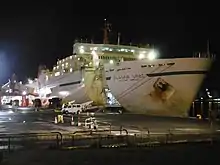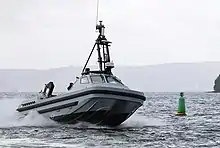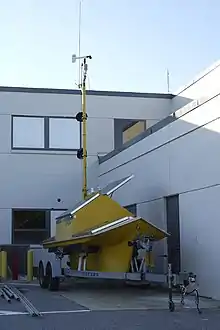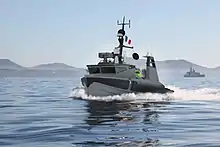Unmanned surface vehicle
An unmanned surface vehicle, unmanned surface vessel or uncrewed surface vessel (USV),[2][3] colloqually called a drone boat, drone ship[4] or sea drone, is a boat or ship that operates on the surface of the water without a crew.[5] USVs operate with various levels of autonomy, from remote control[6] to fully autonomous surface vehicles (ASV).[7]
| Unmanned surface vehicle |
|---|
 |
| Topics |
| Related topics |



USVs were used militarily as early as the 1920s as remote controlled target craft, following the development of the 'DCB's in World War One. By World War II they were also being used for minesweeper purposes. They are becoming more widely used in the twenty-first century for a range of purposes including oceanography and environmental monitoring, as well as cargo transport, and military applications. Various other applications are also being explored. Some commercial USVs may utilize COLREGs-compliant navigation.[8] In October 2022 during the Russian invasion of Ukraine Ukraine armed forces used 7 USVs and 8 UAVs in an attack on multiple Russian naval vessels at the Sevastopol Naval Base. According to Naval News, this represents the first use of unmanned surface vehicles in naval warfare.
Regulatory environment
The regulatory environment for USV operations is changing rapidly as the technology develops and is more frequently deployed on commercial projects. The Maritime Autonomous Surface Ship UK Industry Conduct Principles and Code of Practice 2020 (V4)[10] has been prepared by the UK Maritime Autonomous Systems Regulatory Working Group (MASRWG) and published by Maritime UK through the Society of Maritime Industries. Organisations that contributed to the development of the MASS Code of Practice include The Maritime & Coastguard Agency (MCA), Atlas Elektronik UK Ltd, AutoNaut, Fugro, the UK Chamber of Shipping, UKHO, Trinity House, Nautical Institute, National Oceanography Centre, Dynautics Limited, SEA-KIT International, Sagar Defence Engineering and many more.
In July 2021, SEA-KIT International became the first USV designer and builder to receive Unmanned Marine Systems (UMS) certification from Lloyd's Register for its 12m X-class USV design.
By the end of 2017, Sagar Defence Engineering became the first company in India to build and supply USV to a Government organization.
Development
As early as the end of World War II, remote-controlled USVs were used by the US Navy for target drone and minesweeping applications.[11]: 121 In the twenty-first century, advances in USV control systems and navigation technologies have resulted in USVs that an operator can control remotely from land or a nearby vessel:[12] USVs that operate with partially autonomous control, and USVs (ASVs) that operate fully autonomously.[11] Modern applications and research areas for USVs and ASVs include commercial shipping,[13] environmental and climate monitoring, seafloor mapping,[13][14] passenger ferries,[15] robotic research,[16] surveillance, inspection of bridges and other infrastructure,[17] military, and naval operations.[11]
On January 17, 2022, the Soleil succeeded in completing the first fully autonomous sea voyage by ship. Built by MHI, the demonstration was conducted in cooperation of Shin Nihonkai Ferry.[18] The seven-hour, 240-kilometre voyage, from Shinmoji in Northern Kyushu to the Iyonada Sea, recorded a maximum speed of 26 knots.[19]
In August 2022, the MV Mikage of the Mitsui O.S.K. Lines sailed 161-nautical miles over two days, from Tsuruga to Sakai, successfully completing the first crewless sea voyage to include docking of an autonomous coastal container ship, in a two-day trial.[20]
USV autonomy platforms
A number of autonomy platforms (computer software) tailored specifically for USV operations have been developed. Some are tied to specific vessels, while others are flexible and can be applied to different hull, mechanical, and electrical configurations.
| Name | Vendor | Type | Deployed vessels | Vendor bespoke USVs | Conversion to USV / OEM | COLREGs |
|---|---|---|---|---|---|---|
| Typhoon | Satfinder | Commercial | 2 | Yes | Yes | Capable[21] |
| ASView | L3Harris | Commercial | 100+[8] | Yes | Yes[22] | Capable[8] |
| MOOS | MIT | Open source | No | Yes (open source) | Capable[23] | |
| SM300 | Sea Machines | Commercial | 7 | No | Yes | Capable[24] |
| SDE | Sagar Defence Engineering Private Limited | Commercial | 7 | Yes | Yes | Capable |
Computer-controlled and operated USVs
The design and build of uncrewed surface vessels (USVs) is complex and challenging. Hundreds of decisions relating to mission goals, payload requirements, power budget, hull design, communication systems and propulsion control and management need to be analysed and implemented. Crewed vessel builders often rely on single-source suppliers for propulsion and instrumentation to help the crew control the vessel. In the case of an uncrewed (or partially crewed) vessel, the builder needs to replace elements of the human interface with a remote human interface.
Technical considerations
Uncrewed surface vessels vary in size from under 1 metre LOA to 20+ metres, with displacements ranging from a few kilograms to many tonnes, so propulsion systems cover a wide range of power levels, interfaces and technologies.
Interface types (broadly) in order of size/power:
- PWM-controlled Electronic Speed Controllers for simple electric motors
- Serial bus, using ASCII-coded commands
- Serial bus using binary protocols
- Analogue interfaces found on many larger vessel
- Proprietary CANbus protocols used by various engine manufacturers
- Proprietary CANbus protocols used by manufacturers of generic engine controls
While many of these protocols carry demands to the propulsion, most of them do not bring back any status information. Feedback of achieved RPM may come from tacho pulses or from built-in sensors that generate CAN or serial data. Other sensors may be fitted, such as current sensing on electric motors, which can give an indication of power delivered. Safety is a critical concern, especially at high power levels, but even a small propeller can cause damage or injury and the control system needs to be designed with this in mind. This is particularly important in handover protocols for optionally manned boats.
A frequent challenge faced in the control of USVs is the achievement of a smooth response from full astern to full ahead. Crewed vessels usually have a detent behaviour, with a wide deadband around the stop position. To achieve accurate control of differential steering, the control system needs to compensate for this deadband. Internal combustion engines tend to drive through a gearbox, with an inevitable sudden change when the gearbox engages which the control system must take into account. Waterjets are the exception to this, as they adjust smoothly through the zero point. Electric drives often have a similar deadband built in, so again the control system needs to be designed to preserve this behaviour for a man on board, but smooth it out for automatic control, e.g., for low-speed manoeuvring and Dynamic Positioning.
Oceanography, hydrography and environmental monitoring

USVs are valuable in oceanography, as they are more manouevrable than moored or drifting weather buoys, but far cheaper than the equivalent weather ships and research vessels,[3][25] and more flexible than commercial-ship contributions.[3] USVs used in oceanographic research tend to be powered and propelled by renewable energy sources. For example, Wave gliders harness wave energy for primary propulsion,[26] whereas Saildrones and Sailbuoys use wind. Other USVs harness solar energy to power electric motors, such as Data Xplorer; a product of Open Ocean Robotics, and Xocean. Renewable-powered and persistent, ocean-going USVs have solar cells to power their electronics. Renewable-powered USV persistence are typically measured in months.[27]
As of 2022, USVs have been predominantly used for environmental monitoring and hydrographic survey[3] and future uptake is likely to grow in monitoring and surveillance of very remote locations due to their potential for multidisciplinary use.[3] Low operational cost has been a consistent driver for USV uptake when compared with crewed vessels.[3] Other drivers for USV uptake have change through time, including reducing risk to people, spatio-temporal efficiency, endurance, precision and accessing very shallow water.[3]
Non-renewable-powered USVs are a powerful tool for use in commercial hydrographic survey.[16] Using a small USV in parallel to traditional survey vessels as a 'force-multiplier' can double survey coverage and reduce time on-site. This method was used for a survey carried out in the Bering Sea, off Alaska; the ASV Global 'C-Worker 5' autonomous surface vehicle (ASV) collected 2,275 nautical miles of survey, 44% of the project total. This was a first for the survey industry and resulted in a saving of 25 days at sea.[28] In 2020, the British USV Maxlimer completed an unmanned survey of 1,000 square kilometres (390 sq mi) of seafloor in the Atlantic Ocean west of the English Channel.[29]
Saildrone

A saildrone is a type of unmanned surface vehicle used primarily in oceans for data collection.[30] Saildrones are wind and solar powered and carry a suite of science sensors and navigational instruments. They can follow a set of remotely prescribed waypoints.[31] The saildrone was invented by Richard Jenkins, a British engineer,[32] founder and CEO of Saildrone, Inc. Saildrones have been used by scientists and research organizations like the National Oceanic and Atmospheric Administration (NOAA) to survey the marine ecosystem, fisheries, and weather.[33][34] In January 2019, a small fleet of saildrones was launched to attempt the first autonomous circumnavigation of Antarctica.[35] One of the saildrones completed the mission, traveling 12,500 miles (20,100 km) over the seven month journey while collecting a detailed data set using on board environmental monitoring instrumentation.[36]
In August 2019, SD 1021 completed the fastest unmanned Atlantic crossing sailing from Bermuda to the UK,[37] and in October, it completed the return trip to become the first autonomous vehicle to cross the Atlantic in both directions.[38] The University of Washington and the Saildrone company began a joint venture in 2019 called The Saildrone Pacific Sentinel Experiment, which positioned six saildrones along the west coast of the United States to gather atmospheric and ocean data.[39][40]
Saildrone and NOAA deployed five modified hurricane-class vessels at key locations in the Atlantic Ocean prior to the June start of the 2021 hurricane season. In September, SD 1045 was in location to obtain video and data from inside Hurricane Sam. It was the first research vessel to ever venture into the middle of a major hurricane.[41][42]
Military applications

Military applications for USVs include powered seaborne targets and minehunting,[43] as well as surveillance and reconnaissance, strike operations, and area denial or sea denial.[44]
In 2016 DARPA launched an anti-submarine USV prototype called Sea Hunter. Turkish firm Aselsan produced ALBATROS-T and ALBATROS-K moving target boats for the Turkish Naval Forces to use in shooting drills.[45][46] Turkey's first indigenously developed armed USV (AUSV) is the ULAQ,[47] developed by Ares Shipyard, Meteksan Defence Systems and Roketsan. ULAQ is armed with 4 Roketsan Cirit and 2 UMTAS. It completed its first firing test successfully on 27 May 2021.[48] The ULAQ can be deployed from combat ships. It can be controlled remotely from mobile vehicles, headquarters, command centers and floating platforms. It will serve in missions such as reconnaissance, surveillance and intelligence, surface warfare, asymmetric warfare, armed escort, force protection, and strategic facility security. Ares Shipyard's CEO says that very different versions of ULAQ equipped with different weapons are under development.[49] Its primary user will be Turkish Naval Forces.
In addition, military applications for medium unmanned surface vessels (MUSVs) include fleet intelligence, surveillance, reconnaissance and electronic warfare. In August 2020, L3Harris Technologies was awarded a contract to build an MUSV prototype, with options for up to nine vessels. L3Harris subcontracted Swiftships, a Louisiana-based shipbuilder, to build the vessels, with displacement of about 500 tons.[50] The prototype is targeted for completion by end of 2022. It is the first unmanned naval platform programme in this class of ships, which will likely play a major role in supporting the Distributed Maritime Operations[51] strategy of the U.S. Navy. Earlier, Swiftships partnered with University of Louisiana in 2014 to build the Anaconda (AN-1) and later the Anaconda (AN-2) class of small USVs.[52]
On 13 April 2022, the US sent unspecified "unmanned coastal defense vessels" to Ukraine amid the 2022 Russian invasion of Ukraine as part of a new security package.[53]
A theory was put forward by the BBC that an unmanned surface vehicle was used in the 2022 Crimean Bridge explosion.[54] After explosions at this bridge in July 2023, Russia's Anti-Terrorist Committee claimed that Ukraine used unmanned surface vehicles to attack the bridge.[55]
Use in combat
On 29 October 2022, during the Russian invasion of Ukraine, Ukrainian armed forces made a multi-USV attack on Russian naval vessels at the Sevastopol Naval Base. According to the Russian Defense Ministry, seven USVs were involved in the attack with support of eight UAVs. This represents the first use of unmanned surface vehicles in naval warfare. Naval News reported that little damage had occurred to either of the two warships that were hit by the small USVs, a Russian frigate and a minesweeper. However, the military effect of the attack on the protected harbor of Sevastopol exceeded the direct damage because it led to the Russian Navy going into a protective mode, "essentially locking them in port. ... New defenses were quickly added, new procedures imposed and there was much less activity. Russia’s most powerful warships in the war [were by mid-November] mostly tied up in port." The US Naval Institute reported that, by December 2022, the "Russian Navy now knows it is vulnerable in its main naval base, causing it to retreat further into its shell, increasing defenses and reducing activity outside."[57] A second USV attack occurred in mid-November in Novorossiysk, also in the Black Sea but much further from Russian occupied territory than Sevastopol.[58]
Later in the war, SpaceX restricted the licensing of its Starlink satellite-internet communication technology, excluding direct military use on weapon systems after January 2023. The limitation restricted use of the USV design used by Ukraine in late 2022. At the same time, Russia increased its capabilities in small explosive USVs and used one to ram a bridge on 10 February 2023. The new Russian capability with USVs, and the communication restrictions on the previous Ukrainian USVs, could change the balance in the naval war. In the view of Naval News, "The Black Sea appears to be becoming more Russian friendly again." The potential for wider use of USVs to impact the outcome of conflict remains debated, however, as both physical constraints on existing technology and emerging counter-USV cyber capabilities may render these vessels vulnerable.[60]
An emerging field of research examines whether the proliferation of unmanned surface vessels can impact crisis dynamics or intra-war escalation. An exploratory report on the subject from the Center for Naval Analyses suggests seven potential concerns for military competition, including accidental, deliberate, and inadvertent escalation.[61] While recent scholarship has examined the impact of unmanned aerial systems on crisis management, the empirical record for unmanned surface and subsurface systems is thinner, since these technologies have not yet been widely employed.[62] According to an article published by Reuters, these drones are manufactured at a cost of $250,000 each. They use two impact detonator taken from Russian bombs. With a length of 5.5 metres, they have a camera to allow a human to operate them, and use a water jet for propulsion with a maximum speed of 80 kilometres per hour and an endurance of 60 hours. Given their relative low cost, compared to missiles or bombs, they can be deployed in a mass attack. Their low profile also makes them harder to hit.[63]
On 4 August 2023, the Olenegorsky Gornyak, a Ropucha-class landing ship was seriously damaged in the Black Sea Novorossiysk naval base after it was struck by a Ukrainian Maritime Drone carrying 450 kilograms of TNT.[64] It was pictured listing heavily to one side while being towed back to port.[65]Some 100 service personnel were onboard at the time.[66]
Countermeasures
Due to the drone attack on the Sevastopol Naval Base, in October 2022, Russian forces have developed several countermeasures. They have trained dolphins to protect the Naval Base, while using various booms or nets to stop further attacks. The main change has been the use of Dazzle camouflage, which according to Reuters is "designed to disguise a ship's heading and speed at sea — aims to confuse modern operators of suicide drones and satellites and prevent them from easily identifying important ships", while gunfire from helicopters can be used to destroy Ukrainian drones during an attack.[63][67]
Cargo
In the future, many unmanned cargo ships are expected to cross the waters.[68] In November 2021, the first autonomous cargo ship, MV Yara Birkeland was launched in Norway. The fully electric ship is expected to substantially reduce the need for truck journeys.[69]
Urban vessels and small-scale logistics
In 2021, the world's first urban autonomous vessels, Roboats, were deployed in the canals of Amsterdam, Netherlands. The ships developed by three institutions could carry up to five people, collect waste, deliver goods, monitor the environment and provide "on-demand infrastructure".[70][71]
Seaweed farming
Unmanned surface vehicles can also assist in seaweed farming and help to reduce operating costs.[72][73]
References
- "MOL and Partners Set World Records for Time and Distance in Autonomous Navigation with Sea Trial Using Large Commercial Car Ferry - Follows Successful Trial of Coastal Containership in Autonomous Sailing -". Mitsui O.S.K. Lines. Archived from the original on 2022-02-08. Retrieved 2022-02-10.
- "Uncrewed Surface Vessel Research and Development Program at the NOAA – UNH Joint Hydrographic Center/Center for Coastal and Ocean Mapping" (PDF). Archived (PDF) from the original on 2022-01-22. Retrieved 2021-07-14.
- Patterson, Ruth G.; Lawson, Emily; Udyawer, Vinay; Brassington, Gary B.; Groom, Rachel A.; Campbell, Hamish A. (2022). "Uncrewed Surface Vessel Technological Diffusion Depends on Cross-Sectoral Investment in Open-Ocean Archetypes: A Systematic Review of USV Applications and Drivers". Frontiers in Marine Science. 8. doi:10.3389/fmars.2021.736984. ISSN 2296-7745.
- Mizokami, Kyle (15 January 2019). "The U.S. Navy's Big Push Into Drone Ships Will Lead to Unmanned Vessels Carrying Weapons". Popular Mechanics. Archived from the original on 19 September 2020. Retrieved 19 August 2020.
- Yan, Ru-jian; Pang, Shuo; Sun, Han-bing; Pang, Yong-jie (2010). "Development and missions of unmanned surface vehicle". Journal of Marine Science and Application. 9 (4): 451–457. Bibcode:2010JMSA....9..451Y. doi:10.1007/s11804-010-1033-2. S2CID 109174151.
- "SM200 Wireless Remote-Helm Control System". Sea Machines. 11 December 2020. Archived from the original on 14 July 2021. Retrieved 14 July 2021.
- Niu, Hanlin; Lu, Yu; Savvaris, Al; Tsourdos, Antonios (2018). "An energy-efficient path planning algorithm for unmanned surface vehicles". Ocean Engineering. 161: 308–321. doi:10.1016/j.oceaneng.2018.01.025. hdl:1826/13249. S2CID 115280769. Archived from the original on 2022-06-15. Retrieved 2021-10-19.
- "L3Harris ASView™ Control System". L3Harris. Archived from the original on 14 July 2021. Retrieved 14 July 2021.
- "Maritime Autonomous Surface Ship UK Industry Conduct Principles and Code of Practice 2020". Archived from the original on 2021-09-02. Retrieved 2021-09-02.
- National Research Council, Division on Engineering and Physical Sciences (5 August 2005). Autonomous Vehicles in Support of Naval Operations. National Academies Press. ISBN 978-0-309-18123-5. Retrieved 15 October 2019.
- "USV (UNMANNED SURFACE VEHICLE), APPLICATIONS AND ADVANTAGES". embention.com. Embention. 18 September 2015. Archived from the original on 15 October 2019. Retrieved 15 October 2019.
- Amos, Jonathan (9 May 2019). "Autonomous boat makes oyster run". BBC News. Archived from the original on 6 June 2019. Retrieved 2 December 2019.
- Carson, Daniel F. (2019). "An affordable and portable autonomous surface vehicle with obstacle avoidance for coastal ocean monitoring". HardwareX. 6: e00059. doi:10.1016/j.ohx.2019.e00059.
- "The ferry using Rolls-Royce technology that sails itself". BBC News. Finland. 3 December 2018. Archived from the original on 14 November 2019. Retrieved 15 October 2019.
- Manley, Justin E. (2008). "Unmanned Surface Vehicles, 15 Years of Development" (PDF). IEEE Oceanic Engineering Society. Archived (PDF) from the original on 15 October 2019. Retrieved 14 October 2019.
- Feather, Andrew (1 December 2019). "MDOT: Unmanned sonar-equipped boat to make bridge inspections 'safer and more efficient'". WWMT. Michigan, USA. Archived from the original on 23 July 2020. Retrieved 2 December 2019.
- Emir, Can (2022-01-19). "The World's First Autonomous Ship Just Finished Its First Run in Japan". interestingengineering.com. Archived from the original on 2023-02-08. Retrieved 2023-02-15.
- marinecurrents (2022-01-22). "MHI completed demonstration test of fully autonomous ship systems smoothly". MarineCurrents. Archived from the original on 2023-02-13. Retrieved 2023-02-15.
- "Self-driving cars have nothing on Japan's self-captaining ships". Financial Times. 2022-08-31. Archived from the original on 2023-02-02. Retrieved 2023-02-15.
- "Fully Automated Unmanned Surface Vehicles". Archived from the original on 2022-10-30. Retrieved 2022-10-30.
- "Unmanned Conversions". L3Harris. Archived from the original on 2021-07-14. Retrieved 2021-07-14.
- "MOOS-IvP : Helm - Behavior Avd Colregs browse". oceanai.mit.edu. Archived from the original on 2021-07-14. Retrieved 2021-07-14.
- "Huntington Ingalls Industries Debuts Proteus Unmanned Surface Test Vessel". 20 May 2021. Archived from the original on 14 July 2021. Retrieved 14 July 2021.
- Stevens Institute of Technology student USV Archived 11 August 2010 at the Wayback Machine
- "Carbon Wave Glider". Archived from the original on 3 March 2016. Retrieved 24 February 2016.
- "Robot Boats Survive Epic Voyage Across the Pacific — So Far". WIRED. 23 May 2012. Archived from the original on 28 July 2012. Retrieved 24 February 2016.
- Andrew Orthmann (22 November 2016). "Bering Sea ASV Force Multiplier". Hydro-international.com. Archived from the original on 11 May 2018. Retrieved 10 May 2018.
- "Robot boat completes three-week Atlantic mission". BBC News Online. 15 August 2020. Archived from the original on 29 August 2020. Retrieved 29 August 2020.
- "Drones at sea: Unmanned vehicles to expand data collection from far-flung locales". National Oceanic and Atmospheric Administration. 11 July 2017. Archived from the original on 28 October 2017. Retrieved 28 October 2017.
- Fisher, Adam (18 February 2014). "The Drone That Will Sail Itself Around the World". Wired. ISSN 1059-1028. Archived from the original on 5 June 2019. Retrieved 13 February 2019.
- Vance, Ashlee (15 May 2018). "This Engineer Is Building an Armada of Saildrones That Could Remake Weather Forecasting". Bloomberg. Archived from the original on 20 October 2020. Retrieved 8 September 2020.
- Doughton, Sandi (1 July 2018). "Saildrones go where humans can't — or don't want to — to study the world's oceans". The Seattle Times. Archived from the original on 14 February 2019. Retrieved 13 February 2019.
- Yakowicz, Will (13 June 2017). "Saildrone Hopes Its Robotic Sailboats Can Save the World by Collecting Precise Climate-Change Data". Inc. Archived from the original on 7 June 2019. Retrieved 13 February 2019.
- "Saildrone Fleet Launches in New Zealand on Epic Journey". www.saildrone.com. 21 January 2019. Archived from the original on 14 February 2019. Retrieved 13 February 2019.
- Vance, Ashlee (5 August 2019). "Saildrone's Journey Around Antarctica Uncovers New Climate Clues". Bloomberg Businessweek. Archived from the original on 9 August 2019. Retrieved 15 October 2019.
- Dimitropoulos, Stav (19 November 2019). "The New Ocean Explorers". Popular Mechanics. Archived from the original on 8 March 2020. Retrieved 13 February 2020.
- "Saildrone USV Completes First Atlantic Crossing East to West". www.saildrone.com. 23 October 2019. Archived from the original on 13 February 2020. Retrieved 13 February 2020.
- "The Saildrone Pacific Sentinel Experiment". University of Washington. Archived from the original on 11 November 2019. Retrieved 11 November 2019.
- "Can Autonomous Weather-Observation Sailboats Improve Forecasts over the U.S.?". Cliff Mass Weather and Climate Blog. 10 November 2019. Archived from the original on 11 November 2019. Retrieved 11 November 2019.
- Cappucci, Matthew (30 September 2021). "Scientists drove a robotic surfboard into Hurricane Sam, and the waves were incredible". The Washington Post. Archived from the original on 30 September 2021. Retrieved 30 September 2021.
- Fox, Alex (8 October 2021). "'Saildrone' Captures First-Ever Video From Inside a Category 4 Hurricane". Smithsonian. Washington, D.C. Archived from the original on 10 October 2021. Retrieved 10 October 2021.
- "Fact File: Mine Countermeasures Unmanned Surface Vehicle (MCM USV)". United States Navy. 2 January 2019. Archived from the original on 23 July 2020. Retrieved 14 October 2019.
- Grand-Clément, Sarah; Bajon, Theò (19 October 2022). "Uncrewed Maritime Systems: A Primer". United Nations Institute for Disarmament Research. Archived from the original on 11 December 2022. Retrieved 29 January 2023.
- "Albatros-K unmanned surface target boat" (PDF). Aselsan. Archived (PDF) from the original on 2022-01-26. Retrieved 2021-05-08.
- "Albatros-T unmanned surface target boat" (PDF). Aselsan. Archived (PDF) from the original on 2021-12-16. Retrieved 2021-05-08.
- "ULAQ is the first indigenous armed unmanned surface vessel (AUSV) developed in Turkey". Naval Technology. 19 February 2021. Archived from the original on 12 June 2021. Retrieved 12 June 2021.
- "Turkey Completes First Unmanned Surface Vehicle Live-Fire Trial". 3 June 2021. Archived from the original on 12 June 2021. Retrieved 12 June 2021.
- "Dünya ULAQ SİDA'yı konuşuyor…". YouTube. Archived at Ghostarchive and the Wayback Machine
- "US Navy Awards Contract to L3Harris for Surface Vehicles Programme". Naval Technology. 19 August 2020. Archived from the original on 18 May 2022. Retrieved 16 April 2022.
- "Distributed Maritime Operations - Beery, Paul (CIV)". NPS Wiki. Archived from the original on 2023-02-16. Retrieved 2022-04-04.
- "Anaconda, the Future of Modern Warfare". Militaryleak. 22 August 2017. Archived from the original on 9 December 2021. Retrieved 29 March 2022.
- Bertuca, Tony (13 April 2022). "U.S. sending new weapons package to Ukraine". Inside Defense. Archived from the original on 13 April 2022. Retrieved 13 April 2022.
- "Crimean bridge: Who - or what - caused the explosion?". BBC News. 2022-10-09. Archived from the original on 2022-10-10. Retrieved 2022-11-03.
- "Ukraine attacked Crimean bridge with surface drones, Russia says". Reuters. 2023-07-17. Retrieved 2023-07-17.
- USVs at Work in the Black Sea Archived 2022-11-30 at the Wayback Machine, US Naval Institute, December 2022, Vol. 148/12/1,438.
- Ukraine’s Maritime Drone Strikes Again: Reports Indicate Attack On Novorossiysk Archived 2022-11-19 at the Wayback Machine, Naval News, 18 November 2022.
- Panter, Jonathan; Falcone, Johnathan (February 9, 2023). "Why drone boats are an overhyped Achilles' fleet". Bulletin of the Atomic Scientists. Retrieved May 12, 2023.
- "Impact of Unmanned Systems to Escalation Dynamics" (PDF). Center for Naval Analyses. Retrieved May 18, 2023.
- Panter, Jonathan (April 26, 2023). "Naval Escalation in an Unmanned Context". Center for International Maritime Security. Retrieved May 18, 2023.
- Zafra, Mariano; McClure, Jon (July 17, 2023). "The counteroffensive in Crimea". Reuters. Retrieved July 18, 2023.
- "Russian warship damaged in Ukrainian attack on Novorossiysk naval base - sources". www.reuters.com. 4 August 2023. Retrieved 4 August 2023.
- "Northern Fleet ship seriously damaged in drone attack". thebarentsobserver.com. 4 August 2023. Retrieved 4 August 2023.
- Tom Balmforth (2023-08-04). "Russian warship damaged in Ukrainian attack on Novorossiysk naval base, sources say". Reuters.
- Ozberk, Tayfun (July 17, 2023). "Analysis: Ukraine Strikes With Kamikaze USVs – Russian Bases Are Not Safe Anymore". Naval News. Retrieved July 18, 2023.
- "Unmanned cargo ships". Hellenic Shipping News. 17 March 2017. Archived from the original on 28 May 2018. Retrieved 27 May 2018.
- Deshayes, Pierre-Henry. "First electric autonomous cargo ship launched in Norway". techxplore.com. Archived from the original on 11 December 2021. Retrieved 11 December 2021.
- Gordon, Rachel (27 October 2021). "Self-driving Roboats set sail in Amsterdam canals". Tech Xplore. Archived from the original on 15 November 2021. Retrieved 15 November 2021.
- Lavars, Nick (28 October 2021). "MIT deploys first full-scale autonomous Roboat on canals of Amsterdam". New Atlas. Archived from the original on 23 November 2021. Retrieved 15 November 2021.
- "Newburyport scientist's drone aimed at helping seaweed farmers". Algae World News. 3 October 2017. Archived from the original on 29 December 2017.
- "CA Goudey & Associates". cagoudey.com. Archived from the original on 2021-03-19. Retrieved 2020-09-29.